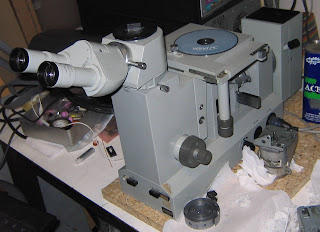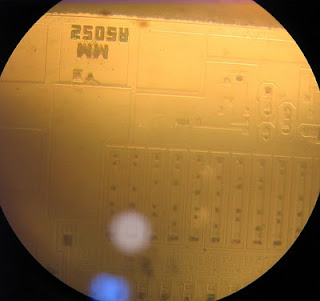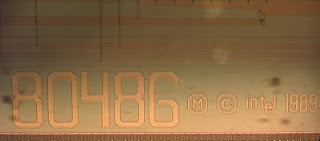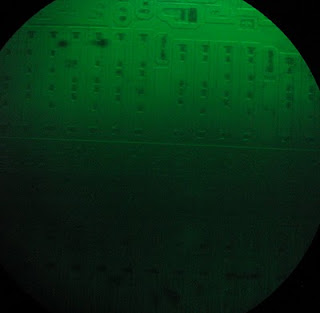Several factors behind this. First, I'm approaching finals and haven't had a lot of time to delve into the deeper layers. Second, I haven't had much success in the few tries I've done to get below the metal layer. Although I should try this more, the initial sanding I tried with a dremel was too course. It had a tendency to produce a relativly uneven surface and take too much off. The HF would take off the top metal layer, but nothing else. I talked to Travis Goodspeed last night and he pointed out I should be (near) boiling the HF. Yum. Tried today briefly and I think I have some progress. However, I really need to take some pictures as I go to get a better idea of exactly what is being corroded.
I had also tried with some NaOH on a P3 die since I heard that is also corrosive to glass. I ordered some KOH which I read somewhere is preferred more in the semi industry, but it got sent to my home in CA by accident, so maybe I'll play with that in a few weeks. First, this is your typical P3 slot 1 die after being tin snip cut from the BGA carrier:
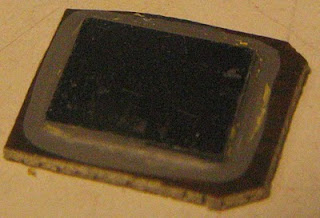
This is actually a metalic blue, but apperas more black in the image. There is a gray epoxy holding it in place and a brown carrier around that. After inspecting the blue area under the microscope, I realized its just a coating to make heat dissipation better and not actually part of the silicon. In fact, you can see crystals poking through it (100X biological microscope):

Unfortunatly, it was somewhat difficult to get a good picture of them, but you get the idea. Thinking this, being a large chunk of silicon, was a good canidate for NaOH etching, I boiled it in some NaOH for a bit. Result (note this is not the exact same chip as above):

Hmm...what are those cracks? I think its stress from using the tin snips. If I was doing this for an imaging sample, I should probably dremel or carefully hacksaw cut them out. In any case, you can see the silicon crystalline surface much better (100X biological microscope):

in this picture, one of the cracks is also visible. I'm actually not sure how much the NaOH etched the surface since I didn't realize the blue wasn't silicon and wasn't really paying attention to see otherwise. I'll try the other side of thise or some other dies I have laying around in the near future.
Also on the not going so well side, this is how my first attempt at a rosin decap ended:
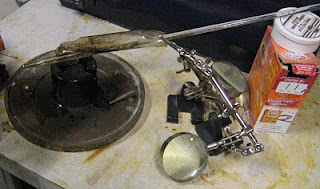
After ordering some borosilicate test tubes, I tried with a heat gun instead since I could control it with a variac and gave more regular results. After a few hours of boiling, a small nick came out of the underside of the chip along the die area, but not corroded as I was hoping. However, a large portion of this time was also devoted to boiling off the petrollium jelly after which the solution darkened and roes in temperature. The CCC IC RE Wiki page (written by Martin Schobert I think) shows the rosin doing more of a higher temp boil. I was at a lower boil. So, I might try to get a propane torch or a more proper alcohol lamp and try that. I'll have a few weeks soon to mess around at home and can probably figure something out. Also, this killed the TCO in the heat gun after I was done.
 Biological interconnect doesn't image well as all black. Sample for comparison (not same area):
Biological interconnect doesn't image well as all black. Sample for comparison (not same area): If you are stuck with a biological microscope, set the intensity as high as you can and you should be able to make things out with your eye, but cameras might have more difficulty.
If you are stuck with a biological microscope, set the intensity as high as you can and you should be able to make things out with your eye, but cameras might have more difficulty. Inverted metallurgical (inverted), interconnect (440X):
Inverted metallurgical (inverted), interconnect (440X):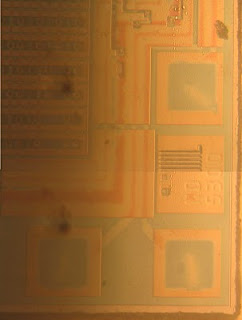 Although all three are from the same chip type, only the two inverted images are from the exact same chip. NOTE: I have done a vertical flip on the inverted images to correct them to what the actual object is like (as in the biological image).
Although all three are from the same chip type, only the two inverted images are from the exact same chip. NOTE: I have done a vertical flip on the inverted images to correct them to what the actual object is like (as in the biological image).


